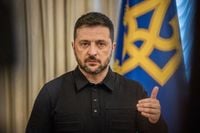On September 29, 2025, Ukrainian President Volodymyr Zelenskyy delivered a significant announcement: Ukraine is set to begin exporting certain types of surplus weapons in a controlled and strategic manner. The move, revealed during his evening address and corroborated by multiple Ukrainian and international news outlets, marks a pivotal development in Ukraine’s approach to sustaining its defense industry and supporting its ongoing war effort against Russia.
According to Censor.NET and the official website of the President of Ukraine, Zelenskyy convened a high-level technological meeting of the Staff of the Supreme Commander-in-Chief. The gathering brought together a broad range of stakeholders, including manufacturers of long-range weapons, Ministry of Defense officials, security and defense forces, and key companies producing Ukrainian drones and missiles. The primary focus was production volumes and the long-term needs of Ukraine’s armed forces.
“The Staff of the Supreme Commander-in-Chief meeting included our weapons manufacturers – producers of long-range weapons. The key issue was production volumes,” Zelenskyy stated, as reported by UNN. “The Ministry of Defense of Ukraine, other government officials, our security and defense forces, as well as all the main companies producing Ukrainian drones and missiles took part in the discussion today. This format works best when everyone is in the same conversation, everyone involved in preparing important decisions can provide real information and has no opportunity to lie.”
During the meeting, reports were presented on Ukraine’s long-range weapon needs—both for the immediate future and the longer term. Zelenskyy emphasized the importance of keeping the country’s arsenals well supplied, noting, “The accuracy of our soldiers helps defend the entire state. We are planning contracts and production to keep our arsenals well supplied.”
One of the most consequential outcomes of the meeting was the decision to initiate controlled exports of certain surplus weapons. Zelenskyy explained that this approach could provide Ukraine with much-needed funds to produce scarce items that are urgently required at the front, particularly those that have proven most effective in striking deep into Russian-held territory. “We are also working on controlled exports of certain types of weapons we have in surplus. This can provide Ukraine with additional funds to produce the scarce items that are urgently needed on the front now and those that have proven most effective in striking deep inside Russian territory,” he said.
Agreements have already been reached on four export platforms: the United States, Europe, the Middle East, and Africa. Preparations are underway to formalize the relevant agreements, and Zelenskyy indicated that proposals had already been received from several African nations, with Kyiv having selected its first partner country. More details are expected to emerge soon, according to The Kyiv Independent.
This export strategy is not without its internal debates. Zelenskyy acknowledged that there were differences in assessments at the Staff meeting regarding Ukraine’s production potential and the actual capabilities of its companies. “We must produce as much as possible, and our Ukrainian production capacity is still far from being fully utilized. We are channeling Ukrainian funding so that every company capable of delivering quality results receives orders and can fulfill them in full. Our partners are helping us financially, especially with drones. This is important and tangible, and I thank you for that. The task of the Ministry of Defense and all involved institutions is to ensure that manufacturers receive as many orders as they can realistically fulfill,” the president added.
The export of Ukrainian-made weapons is a highly regulated process, with domestic manufacturers requiring difficult-to-obtain permits from the State Export Service. Earlier this year, more than 200 Ukrainian drone companies—part of a rapidly growing sector since the full-scale Russian invasion in 2022—issued a public letter urging Zelenskyy to lift export restrictions, particularly for military-grade drones. Despite their pleas, the president has made it clear that while controlled exports will proceed, the priority remains replenishing the Ukrainian army. “I am not sure that all of our businesses are satisfied — they want to sell everything everywhere at once — but of course our priority is replenishing the Ukrainian army. And that will be our priority until the end of the war in any case, therefore, exports will be controlled until the end of the war,” Zelenskyy said, as reported by The Kyiv Independent.
Ukraine’s defense industry has witnessed explosive growth since 2022, especially in the drone sector. Over 200 companies now design and manufacture unmanned systems, building cheap and adaptable technologies that have reshaped the battlefield. However, the industry’s production capacity has begun to outpace available financing, making controlled exports a potentially vital source of revenue for sustaining and expanding domestic production.
International partnerships continue to play a crucial role in supporting Ukraine’s defense efforts. On the same day as the export announcement, a Ukrainian delegation led by Deputy Defense Minister Serhii Boyev departed for the United States to attend talks on joint drone production. The visit, reported by Suspilne, comes as Washington moves to finalize agreements to purchase American weapons and export domestically produced drones. Discussions are expected to center on technical issues, with Ukraine seeking both a “Mega Deal” for purchasing U.S. weapons (a wish list totaling around $90 billion) and a “Drone Deal” to sell Ukrainian unmanned systems to the U.S.
During his recent visit to the U.S., Zelenskyy met with President Donald Trump and discussed the main points of these deals. “We have discussed the main things, agreed with the (U.S.) president, now we are moving on to practical implementation,” Zelenskyy said. Kyiv is also pursuing separate agreements for other types of weapons, particularly long-range missiles. According to The Telegraph, Zelenskyy requested long-range Tomahawk cruise missiles from Trump during their meeting at the United Nations—a move that, if successful, could significantly enhance Ukraine’s strike capabilities.
Ukraine’s efforts to bolster its defense are not limited to exports and foreign purchases. The country is also expecting additional deliveries of Swedish Gripen, French Mirage, and American F-16 jets under the PURL program, supported by European allies and the U.S. to strengthen its air defense. Zelenskyy confirmed that Ukraine had received a Patriot air defense system from Israel, which has already been operating for about a month, and that two more Patriots are expected from Germany later this year. German Defense Minister Boris Pistorius corroborated these deliveries at the Warsaw Security Forum.
The context for these moves is shaped by the evolving international response to the war in Ukraine. Germany, France, the UK, and the U.S. have recently lifted restrictions on the supply of long-range weapons to Ukraine, enabling Kyiv to strike deeper into Russian territory—a move the Kremlin has condemned as dangerous and counterproductive to peace efforts.
As Ukraine navigates these complex dynamics, Zelenskyy’s administration is focused on maximizing domestic production, ensuring the efficient use of international aid, and leveraging controlled exports to sustain the war effort. The government’s strategy aims to maintain a stable supply of equipment for the front lines while building the financial and industrial base needed for long-term security and resilience.
With agreements already in place across four continents and a robust domestic industry eager for new opportunities, Ukraine’s controlled export initiative signals a new chapter in its defense policy—one that balances immediate military needs with the promise of future stability.


